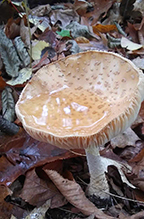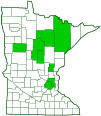Blusher
(Amanita rubescens)
Conservation • Description • Habitat • Ecology • Distribution • Taxonomy
Conservation Status |
|
|||||||
| IUCN Red List | not listed |
|||||||
| NatureServe | NNR - Unranked |
|||||||
| Minnesota | not listed |
|||||||
Description |
||
Blusher, also known as Blushing Amanita, is a common and widespread gilled mushroom. It occurs in Europe and North America, and it has been recorded in China and Australia. It has also been recorded in South Africa, where it is believed to have been accidentally introduced. In the United States it occurs east of the Great Plains and west of the Rocky Mountains, with only a handful of records between. Blusher is found in summer and fall in deciduous, coniferous, and mixed forests. It appears alone, scattered, or in groups but not clustered (gregarious). It grows on the ground under hardwoods, especially oaks, but also ash, birch, hickory, and maple. It also grows under pines and other conifers. It has a mutually beneficial relationship (mycorrhizal) with the tiny rootlets of trees, absorbing sugars and amino acids while helping the tree absorb water. When it first appears, the cap is broadly cone-shaped and pale yellowish tan or tannish yellow. The margin is curved inward. The surface is tacky and is densely covered with numerous felty, almost pyramid-shaped, pale yellow to yellow, sometimes bright yellow, warts. The warts are remnants of the universal veil. As it ages it turns pale tan and the cap spreads out, becoming first hemispheric or very broadly bell-shaped, then broadly convex above and flat below. Mature caps are flat or shallowly depressed, 1½″ to 6″ (40 to 150 mm) in diameter, and flushed pinkish, reddish-brown, or brown. The margins are curved downward and are usually not lined. The surface is dry and covered with scattered, tan to pale brown warts. The gills are white and closely spaced. They are narrowly attached to broadly attached to the stalk when young, sometimes becoming unattached (free) from the stalk in age. Between the main gills there are numerous, unevenly distributed, short gills that do not reach the stalk. The stalk is 2″ to 7″ (5 to 18 cm) long, ⅜″ to 1¼″ (1 to 3 cm) thick. It broadens toward the bottom, sometimes to a bulb-like base. There is a persistent, fragile, skirt-like ring of tissue, remnants of the partial veil, near the top. The stalk is white at first, becoming stained pinkish, reddish, or reddish brown below the ring. It may be bald or covered with fine hair-like fibers. There are many soft scales near the base, more remnants of the universal veil. The ring eventually colapses and sheathes the stalk. The flesh is firm, white, and thick at the stalk, becoming thin at the margin. It slowly turns pink or reddish when bruised. This is the feature that gives the mushroom its common name. It is non-poisonous when properly cooked, but indigestible or even poisonous when raw. The mushroom is also easily mistaken for other species that are poisonous. For these reasons, eating is not recommended. The spore print is white. |
||
Similar Species |
||
Habitat and Hosts |
||
Deciduous, coniferous, and mixed forests Oaks, ash, birch, hickory, maple, pines, and other conifers |
||
Ecology |
||
Season |
||
Summer and fall |
||
Pests and Diseases |
||
Amanita Mold (Hypomyces hyalinus) covers the entire mushroom with a soft, whitish to pinkish coating and causes the growing mushroom to become disfigured. |
||
Distribution |
||||
|
Sources |
|||
| 11/6/2023 | ||||
Occurrence |
||||
Common |
||||
Taxonomy |
|||
| Kingdom | Fungi (Fungi) | ||
| Subkingdom | Dikarya | ||
| Phylum | Basidiomycota (Basidiomycete Fungi) | ||
| Subphylum | Agaricomycotina (Higher Basidiomycetes) | ||
| Class | Agaricomycetes (Mushrooms, Bracket Fungi, Puffballs, and Allies) | ||
| Subclass | Agaricomycetidae | ||
| Order | Agaricales (Common Gilled Mushrooms and Allies) | ||
| Suborder | Pluteineae | ||
| Family | Amanitaceae (Amanita mushrooms and allies) | ||
| Tribe | Amaniteae | ||
| Genus | Amanita (Amanita mushrooms) | ||
| Subgenus | Amanitina | ||
| Section | Validae | ||
Subordinate Taxa |
|||
Amanita rubescens is a highly variable species. At least 23 subspecies, varieties, and forms have been described based on morphology, microscopic characteristics, and genetics. MycoBank recognizes all of them. Index Fungorum recognizes none of them. GBIF recognizes two subspecies, one variety, and two forms. The Amanita rubescens in eastern North America is probably not the same as the common European species with the same name. Recent and ongoing genetic testing have so far separated one subspecies and eight distinct species. The subspecies is the white-capped Eastern American White Blusher (Amanita rubescens var. alba). Three of the new species share the same provisional name Amanita amerirubescens. The cream colored to tan mushrooms are often identified only to the species level. |
|||
Synonyms |
|||
Amanita rubescens f. alba Amanita rubescens f. alutacea Amanita rubescens f. annulosulfurea Amanita rubescens f. annulosulphurea Amanita rubescens f. elegantius Amanita rubescens f. exannulata Amanita rubescens f. rubescens Amanita rubescens f. virescens Amanita rubescens var. alba Amanita rubescens var. alutacea Amanita rubescens var. annulosulphurea Amanita rubescens var. circinata Amanita rubescens var. circinnata Amanita rubescens var. communis Amanita rubescens var. congolensis Amanita rubescens var. elegantissima Amanita rubescens var. genuina Amanita rubescens var. incarnata Amanita rubescens var. magnifica Amanita rubescens var. radicata Amanita rubescens var. rubescens Amanita rubescens var. verrucosa Amanita rubescens var. virescens |
|||
Common Names |
|||
Blusher Blushing Amanita |
|||
Glossary
Mycorrhizal
A symbiotic, usually beneficial relationship between a fungus and the tiny rootlets of a plant, usually a tree.
Partial veil
A protective covering over the gills or pores of a developing mushroom. At maturity it disappears, collapses into a ring around the stem, or wears away into a cobwebby covering and ring zone.
Universal veil
An egg-like structure that envelopes all or most of a developing gill mushroom. Remnants of the universal veil sometimes visible on a mature mushroom are patchy warts on the cap, a ring on the stem, and a volva at the base of the stem.
Visitor Photos |
|||||
Share your photo of this fungus. |
|||||
| This button not working for you? Simply email us at info@MinnesotaSeasons.com. Attach one or more photos and, if you like, a caption. |
|||||
Luciearl |
|||||
This one was holding water like a chalice |
|||||
 |
|||||
MinnesotaSeasons.com Photos |
|||||
|
|||||

Visitor Videos |
|||
Share your video of this fungus. |
|||
| This button not working for you? Simply email us at info@MinnesotaSeasons.com. Attach a video, a YouTube link, or a cloud storage link. |
|||
Other Videos |
|||
| The Blusher - Foraging Mushrooms UK (Amanita Rubescens) Totally Wild UK |
|||
About
Sep 22, 2022 Through this video, we're going to take a look at how we can all safely forage for Blusher mushrooms which are one of the mushrooms we find a lot in the wild but also need to be careful of when foraging as they have some deadly toxic lookalikes. These Wild Mushrooms can be foraged in plenty of different woodland locations and I come across these really regularly throughout the whole of the fungi season from June to November. Through this video, we'll look at some of our favourite ways to cook with our foraged wild Blushermushrooms as well as the potential lookalikes for the Blushermushrooms. The Blusher Mushroom Lives within the Amanita Family of Mushrooms, within this family sit some deadly toxic mushrooms, mainly the death cap, the destroying angel and the panther cap which is the one that looks most similar to the Blusher mushroom. For a full written identification guide for Blusher mushrooms head over to the mushroom guide section of the site. Happy Foraging Mushrooms |
|||
| BLUSHER MUSHROOM in Berkshire UK | Amanita Rubescens Truffle Forager |
|||
About
Sep 8, 2021 |
|||
| Introducing the blusher, Amanita amerirubescens species group Anna McHugh |
|||
About
May 9, 2023 In this video, I explain how to identify the blusher, which is a group of Amanita mushroom species that are extremely common in the Southeastern US. Edible though not particularly sought after in North America, blusher mushrooms in the eastern US are collectively called Amanita amerirubescens group. I also explain a few mushroom hunting basics: How to recognize the Amanita genus, how to collect mushrooms for identification, and the several fungal lifestyles that affect where and how and when to find wild mushrooms. |
|||

Created: 11/6/2023
Last Updated:




